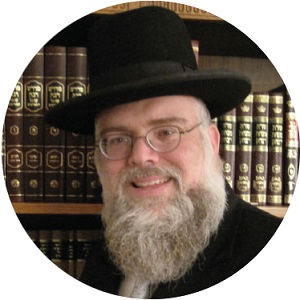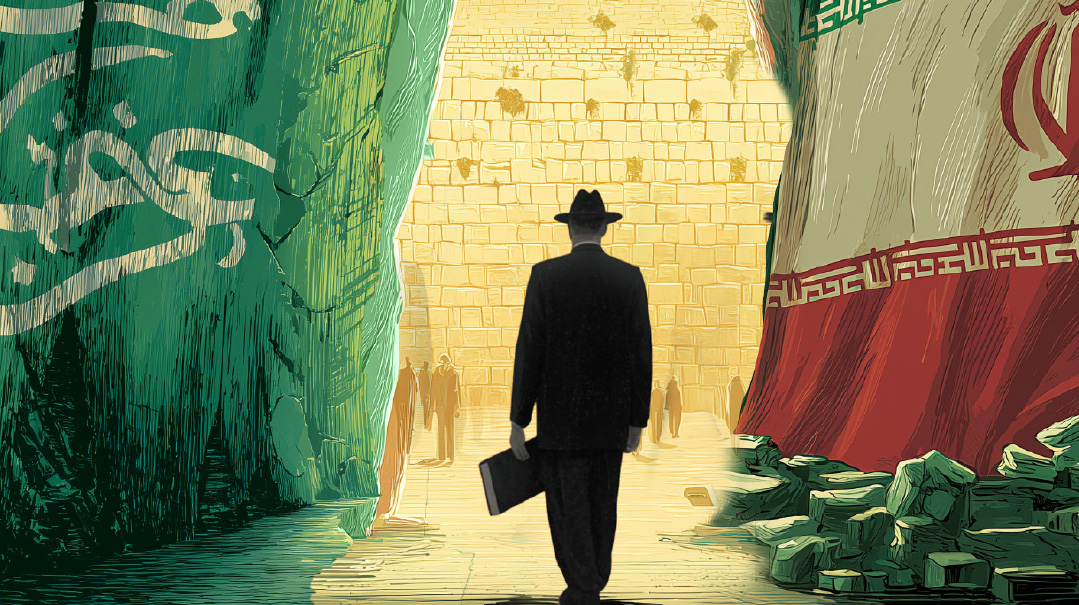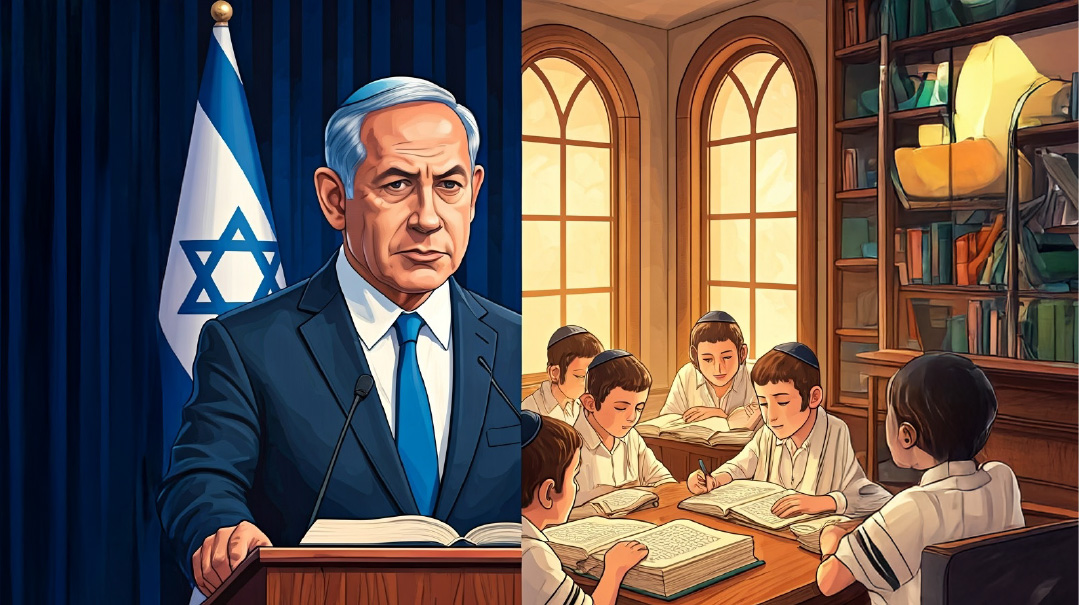Your Time Is Also a Gift

We have made it a staple of our Purim morning to personally visit individuals who appreciate the company the most

T
he most stressful life events, we are told, are divorce, a death in a family Rachmana litzlan, and moving. Whoever compiled that list could not possibly have been a shomer Torah u’mitzvos, because of one obvious omission — preparing and giving mishloach manos.
Somehow, the memories of my youth don’t match up with the current reality — although growing up in Boston in the ’60s certainly can’t compete with today’s frenzy in Brooklyn, Lakewood, Chicago, or Eretz Yisrael. Back in those “olden days,” the women would put some pieces of homemade strudel and cookies on a paper plate, with perhaps an orange or bottle of wine, and send it off with one of the children.
Every family, of course, had its own special shalach manos recipients, and mine was no exception. I clearly recall two special shalach manos we gave each year. One was to “the Rav,” Rav Mordechai Savitsky ztz”l, who would receive a sponge bundt cake with a bottle of wine in the middle, made with reverence and admiration by my mother a”h. It came with a price tag, though. I had to get farhered in the process. But I would walk away with the incredible sum of five dollars for my troubles. (You could get a new Chevy for as little as $2,000 back then. This was serious cash.)
The other special delivery was to my Uncle Shloime’s elderly aunt, known simply as Moomie, who lived in Revere, Massachusetts, quite a distance from Boston. The price tag for our visits to Moomie were her teiglach, which could fill our existing cavities while creating new ones. (I never knew her real name. Her husband was simply known to me as “Uncle.”) It was a significant drive each way, but to me, that was Purim. A half hour at the Rav’s, and an eternity at Moomie’s.
Why would anyone care about the Purim of my youth? Because there was a lesson in those trips in those simple, carefree days that has remained with me for almost 60 years. Allow me to share it.
Did you ever wonder where the popular expression “shalach manos” comes from? It’s not from the Megillah, that’s for sure. There, it’s called mishloach manos. Where did this new term for this beloved mitzvah come from?
I would humbly suggest that it has its source in a pasuk in Nechemiah (8:10). There, Nechemiah describes the depression and lack of resources among those who returned from Bavel to Eretz Yisrael in the days of Ezra. Many people were destitute physically, but even more so spiritually, some having even intermarried.
It was Rosh Hashanah, and Nechemiah exhorted the nation to share in their brothers’ and sisters’ plight and elevate their spirits by sending gifts of food to those who didn’t have anything ready to eat — “V’shilchu manos l’ein nachon lo.” (Perhaps this is an allusion to the halachah that mishloach manos should specifically consist of ready-to-eat food.) The point of these gifts was twofold. First, to provide food for those who needed it, and more importantly, to lift their spirits and pull them out of the doldrums of despair.
This was the shalach manos of that time. Now that we have made that phrasing part of our Jewish parlance for eternity, perhaps it should serve as our guide for how to perform our shalach manos, bayamim haheim bazman hazeh.
Many of us feel compelled to deliver shalach manos to any number of friends and neighbors, business associates, teachers, and anyone else we are afraid will feel slighted if we skip them. Although it is understandable, we have created a situation that is unsustainable and overwhelming. It is also not nearly as meaningful as when we take the time to focus on a few individuals and actually sit down for a few moments and talk with them. Hit-and-run shalach manos do not hold a candle to providing company to someone who is “ein nachon lo” in the world he or she lives in.
In our family, we have made it a staple of our Purim morning to personally visit individuals who appreciate the company the most and spend some quality time with them. My talmidim know not to bother coming to our house during those hours. We are striving to fulfill the mitzvas hayom in the true spirit that was intended, and I make a point of teaching this to them.
Every year seems to create its own memories that show how meaningful these special visits can be. One year, while delivering shalach manos in an assisted-living facility, we were tipped off that an elderly couple who had davened in our shul many years ago had recently moved into one of the apartments. Having packed extra shalach manos for just such an eventuality, we stopped by, only to discover the husband was suffering from Parkinson’s disease. We sat with them for a significant amount of time as it was obvious how much our company meant to them, until we finally had to take leave. By the time we left, there was a great sense of “kashah alai preidas’chem.”
Then there was a young family who had recently welcomed a new baby, who was sadly very ill. We stopped in then for just a few minutes, yet we still hear about it years later. Neither of these encounters was even on our original list, but both reinforced for us what this mitzvah can really accomplish when done properly and with meaning.
This year is especially challenging, as Purim is Erev Shabbos; we must eat our seudos early, and we must also prepare for Shabbos. Would it be too bold to recommend we rethink our shalach manos plans and pinpoint those who need us the most? Could we dare bypass our friends, whose closeness does not depend on our chocolate sushi and deaux de la pois pastries, and instead go with our children to a moshav zekeinim, to forgotten friends and acquaintances, or to those who would simply love to be recognized and thought of, and be mesameiach them with our very presence? Should rebbeim and moros encourage their precious charges to make the most of a short Erev Shabbos and spend their time where it is needed and appreciated the most, maybe even forgoing their own two minutes with each student?
Having been a veteran of Purim for quite some time as both a rav and rebbi, and on the receiving end of mispallelim and talmidim coming over for some simchas hayom and a vort, I can honestly say that the best visits are from those who linger around my table for more than just a moment, both for me and for them.
One neighbor came over two years ago at “just the right time,” and he boldly asked me to make a seder in learning with him. In my ultra-freilich state of mind, or lack of it, I accepted. It is 24 months later and our Minchas Chinuch chavrusashaft is still going strong. It would have never happened had he and his wife simply dropped off a cake and run off to the next delivery. Another old acquaintance from my yeshivah days was in town for Purim and spent over an hour with me just to reconnect in a way that only Purim allows. It was a veritable Gan Eden. He will never know how much it meant to me.
When our children were young, they would relish being in the company of Rav Yehoshua Eichenstein ztz”l, the Zidichover Rebbe, when they brought him shalach manos and received a half-dollar coin in return. They still talk today, over 30 years later, about the vort he would tell them about every Yid being a half of a whole, and the love he would shower on them. This would not have happened hit-and-run style.
And there were visits to the great tzaddik Rav Eshia Twersky ztz”l and his Rebbetzin a”h, as my impressionable little boys basked in the kedushah and warmth of one of the jewels of Chicago, while being plied with teiglach. (Their daughter still sends teiglach for shalach manos every year, just to preserve the memories.)
IT is worth noting the words of Rav Yehonasan Eibeschutz (Yaaros Devash, chelek alef, drush 8) to give our shalach manos just a little more meaning and significance. The Megillah makes a point of recording how Esther was a “noseis chein b’einei kol ro’eiha.” Everyone had a special fondness for her, and as the Gemara adds, everyone looked at her as one of their own (nidmesa l’chol echad k’umaso). This was due to Esther’s incredible humility and respect for others.
We may add that Mishlei indeed teaches us, “la’anavim yitein chein.” Chein is a direct outgrowth of humility. The Midrash goes so far as to say Esther was even noseis chein in the eyes of the malachim in heaven. With them, it wasn’t a matter of impressing anyone; angels are way beyond that. Esther had perfected a great trait, making her the perfect candidate to become the heroine of the Purim story, for there is no greater maaleh than humility.
This is why we send shalach manos. We demonstrate our ambition to reflect the greatness of Esther, to be beloved by all through our humility and selflessness, particularly toward the weak and depressed among us, to share in their pain and feel compassion for them. Through this, we too will find chein, both down here and up there, just like Esther. This will in turn generate chein and chesed from Hashem toward us. (See Yerach L’moadim from Rav Yerucham Olshin, who derives the same lesson based on the words of the Chofetz Chaim in a number of places.)
Hence, our shalach manos is much more than merely a gift of food. It is actually a vehicle for transforming our act of kindness into Heavenly chesed that has the power to bring great yeshuos to the world. This is certainly something to think about while sitting in traffic with a car loaded with goodies waiting for the light to turn green.
At the cornerstone laying of the Ponevezher beis medrash in Bnei Brak, the legendary Ponevezher Rav was asked by an attendee what gave him the ambition and desire to reach the great pinnacle to which he had ascended. The Rav related that in the city of Kula where he grew up, it was customary for one of the children to be honored with delivering the shalach manos on behalf of the city. One year, he was chosen, as a boy of 11 years old. Kula was a poor community, but the women always prepared a most beautiful and choshuve gift of cakes, cookies, and the like, and arranged the delicacies on a tray, complete with a bottle of wine.
That particular year, the city’s rav was going to get a special treat. A candle factory had opened up outside town, and the townsfolk chipped in for a box of candles and a new Gemara Bava Basra to include in the shalach manos. Young Yosef Shlomo Kahaneman entered the rav’s house. The rav took the wine and placed it down, followed by the tray. The future gadol b’Yisrael then presented his rav with the candles and the Gemara.
Tears of joy began rolling down the rav’s cheeks as he cried and exclaimed, “Now I can learn Torah at night! And with a beautiful new Gemara.”
That moment, the Ponevezher Rav said, gave him the ambition and drive to become great in Torah. The rest is history. And it could never have happened had he simply dropped off his gift and gone off to the next address.
WE are all starving for simchah. On Purim, we were given the opportunity not only to experience it ourselves, but more importantly to share it where it is needed most.
Let’s make this Purim the most meaningful it can be. Let’s go old-school and leave hitting and running for baseball games and irresponsible drivers. It has no place at shalach manos. Let us all make the most of this special day by promoting true ahavah and friendship. Stick around a few minutes with your strudel and cookies, if you can. It might change us all forever.
Rabbi Henoch Plotnik, a talmid of the yeshivos of Philadelphia and Ponovezh, has been active in rabbanus and chinuch for 25 years and currently serves as ram in Yeshivas Me’or HaTorah in Chicago.
(Originally featured in Mishpacha, Issue 1053)
Oops! We could not locate your form.






